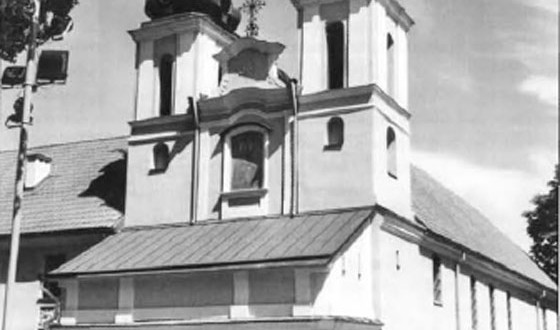by Val Ramonis photographs by the author

Two sanctuaries in Vilnius reflect the nation’s desire to revive its neglected and forgotten religious, cultural, and historic heritage.
EVERY TIME I AM IN VILNIUS, I MAKE A POINT I I to revisit some of my favorite sites, or to discover new ones I didn’t even know existed. And this summer was no exception.
The Lithuanian capital, by American standards, is not a very large city, so you can cover its entire Old Town section by foot in a few hours.
I don’t think I am any more religious than the average person, but I do have a certain fascination for the churches in Lithuania, and particularly those in Vilnius. Compared to other European cities, the Vilnius Old Town probably has more churches per square mile than any other city. Each one has its own character, and each one is a showcase of beautiful art and architecture. Churches are some of the oldest structures that have survived to this day, and they have been witnesses to some of the most important events in the country’s history. Many were destroyed during past wars and foreign occupations, but of those that have survived, some can boast ages of 600-700 years.
Of legends and history
Of the many churches in Vilnius, one of the smallest – and perhaps one of the least known to the casual visitor – stands almost across from the Presidential Palace on Daukanto Square, a short distance from Vilnius Cathedral. It’s the Church of the Holy Cross, which is part of the monastery complex of the same name.
At one time in the distant past, the monastery belonged to the Bonifrat Brothers, a branch of the Order of St. John of God. Currently it houses the Sisters of the Immaculate Conception of the Blessed Virgin Mary, who have been restoring it after many years of neglect and misuse. This Order of nuns, known in Lithuania as the Sisters of the Poor (Vargdieniu seserys), was founded by Blessed Jurgis (George) Matulaitis in 1918 to help meet the needs of the Church and of the people of Lithuania. The Sisters also run the Holy Cross House, a social center located on the monastery grounds. The center provides counseling and psychological and legal assistance to poor families and those afflicted by social problems such as alcoholism and drug abuse, depression, spouse abuse, mental problems, and others. Social workers, psychologists, lawyers, priests, nuns, and other professionals provide these services to the poor free of charge. In addition to the Holy Cross Monastery and Social Center in Vilnius, the Order also runs various other centers and projects in Kaunas, Marijampole, Alytus and Utena, as well as in the United States and Canada.
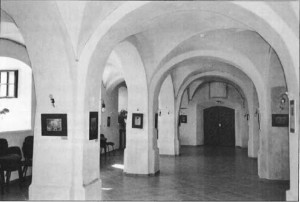
The church and monastery have both semi-legendary and historical origins. According to tradition, the first small wooden church was built around 1332, on the same site where a group of Franciscan monks were martyrized. This church burned down in 1533. In 1543, Vilnius’ Bishop Povilas Alšeniškis built the Fioly Cross Chapel on the site of the original church.
The church and monastery have both semi-legendary and historical origins. According to tradition, the first small wooden church was built around 1332, on the same site where a group of Franciscan monks were martyrized. This church burned down in 1533. In 1543, Vilnius’ Bishop Povilas Alšeniškis built the Fioly Cross Chapel on the site of the original church. In 1635, Vilnius’ Bishop Abraomas Vaina invited the Bonifrat friars to settle next to the chapel. A larger house nearby was expanded and converted into a church, and the old chapel was incorporated into the construction of the monastery. The main mission of the friars was the care of the poor and the sick. This was the beginning of the first hospital in Lithuania. From 1651 the monastery came under the personal patronage of Bishop Jurgis Tiškevicius. The church was embellished with five beautiful altars and a painting of the Virgin Mary. A copy of this painting was later painted on the church’s facade. W hat has made this church famous, and truly special to the local inhabitants, is the natural spring which flows from under the church’s foundation. Legend has it that the spring began flowing from the same spot where the Franciscan monks were martyrized in the 14th century. People have always believed that the spring’s water has miraculous and curative powers.
In 1737, and again in 1748, the church was badly damaged by fire.
The entire monastery complex developed throughout the 17th and 18th centuries. It included the monastery itself, the church, the hospital, and several additional buildings used for service and maintenance purposes.
In 1843, the czarist Russian government ordered the monastery closed, and the church given to lay priests.
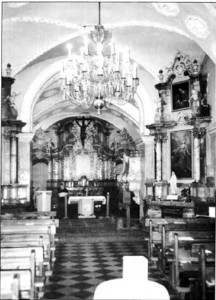
The hospital, which was the first psychiatric hospital in the country, was transferred to another location.
In 1904, the rundown church was renovated by the parishioners themselves.
In 1924, Vilnius5 Bishop Jurgis (George) Matulaitis invited the Bonifrat Brothers to return to Lithuania and resume their work at the monastery. But in 1940, at the start of W orld W ar II, the Order of St. John of God recalled the Bonifrats from Lithuania.
In 1947, Bishop Mecislovas Reinys invited the Sisters of the Immaculate Conception of the Blessed Virgin Mary to settle in the old monastery. Two years later, Soviet authorities ordered the church and the monastery closed, and the monastery converted into an apartment complex.
In 1976, the church was converted into a classical music concert hall. Because of its beautiful Baroque interior, it became known as the “Small Baroque Hall.”
Without much maintenance and upkeep, the monastery and its apartments fell into disrepair and decay. After more than forty years of misuse and neglect, the monastery looked like South Beirut after an Israeli bombing raid.
In 1991, by a property restitution act, the monastery complex was returned to its rightful owner, the Diocese of Vilnius.
In 1995, the Diocese assigned the renovation and administration of the church and monastery to the Sisters of the Immaculate Conception of the Blessed Virgin Mary.
In 2001, the Holy Cross Social Center was inaugurated, and on October 16 of the same year, Cardinal Audrys Juozas Backis blessed the renovated monastery. Since 1998 the monastery and the Holy Cross Center are being administered by Sister Igne, the provincial of the Order of Sisters, and her assistant Sister Dalia.
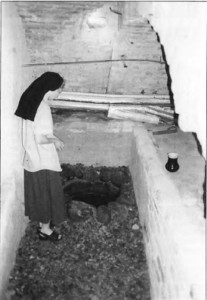
Sister Igne Marijošius was born in Lithuania, but spent most of her life in the United States. Her father is the famous conductor and Lithuanian opera theater director Vytautas Marijošius, and her mother Kotryna is a renown choreographer and folk dance creator. Sister Igne lived in Hartford, Connecticut most of her life, and for many years was the director of the Neringa Summer Camp at Brattleboro, Vermont. In 1998 she came to Lithuania to assist the Bishops’ Conference with the preparations for the celebration of the 2000 jubilee year, and decided to stay.
Sister Dalia, a young but very energetic nun, gave me a tour of the church and the monastery complex. The church is a jewel of Baroque art; its walls and ceiling are filled with hundreds of beautiful carvings of saints, angels, and other decorative elements. This is the result of the many renovations the church has gone through during the 17th and 18th centuries, and also in the last 10 years. Attached to the church is a hall with a vaulted ceiling where lectures, meetings, and small concerts of religious or classical music are occasionally held.
You can see elements and details from earlier periods all throughout the monastery, on outside and inside walls and along staircases, including sections of walls built in the 16th century. The original chapel built by Bishop Povilas Alšeniškis in 1543 still stands, but its interior is in sad shape. It was being cleaned and renovated when I visited, and it should become a beautiful place again once the work is finished. Sister Dalia told me that not much of the interior will be changed, so that the original centuries-old decor can be preserved and admired. She said that the chapel will become a quiet, restful place where the Sisters can pray and meditate in private. The original placque that was attached to the chapel’s outside wall in 1543, indicating that it was built by Bishop Povilas Alšeniškis, was uncovered and restored.
Sister Dalia also took me into the cellars underneath the church, where she showed me the miraculous natural spring. The water flows into a small well, and no matter how much water is taken out of it, it fills up again very quickly. Another Sister approached us with a glass full of the spring’s water, and asked me if I wanted to take a sip. She said the common belief is that the water relieves eye problems. I said, sure; a magazine editor has to have good eyes. She also told me that in earlier times, a pipe directed the water from the spring into the church, where people could take a sip or fill a cup. It is no longer the case, perhaps for sanitary reasons.
The Sisters are very energetic and do most of the maintenance work themselves. They also provide other services to the poor, such as doing laundry for families that cannot afford washing machines. The day I visited, Sister Igne was busy mowing the lawn with an antiquated manual mower. She told me that while much had been done to restore the monastery during the past ten years, much more was needed to be done. And that their main source of income are donations.
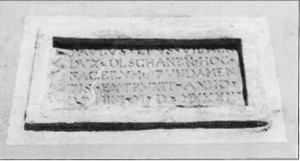
If any readers wish to help the Sisters with the renovation of the monastery or to support the Holy Cross Social Center, they can write to Sister Igne in either English or Lithuanian. Their address is Sv. Kryžiaus Namai, S. Daukanto a. 1, Vilnius, LT- 01122, Lithuania. Their email address is kryziausnamai@mvs.Icn.It.
Franciscan heritage
nother interesting church I came across during this trip is located on Traku St., also in the city’s Old Town section but a little distance from the beaten path. It is the Church of the Assumption of the Virgin Mary. Its facade is a combination of Gothic and Baroque architecture, and it is one of several churches the Franciscan Order built in Vilnius.
The Franciscans were the first Catholic monks to come to a pagan Lithuania. They arrived around 1250, less than 30 years after the death of their O rder’s founder, St. Francis of Assisi. They were present at the baptism and coronation of Lithuania’s first king, Mindaugas, in 1251-1253. During King Gediminas’ time, they already had two monasteries in Lithuania, one in Vilnius and the other in Naugardukas. Many of them suffered martyrdom, as I described earlier, while spreading the Christian faith among the pagan Lithuanians. In 1341 alone, 36 Franciscans were put to death for that particular reason.
It is generally believed that the Church of the Assumption of the Virgin Mary was built by order of King Vytautas the Great in the early 15th century. In the 16th century, a large complex of Gothic brick structures was built next to the church, which included a monastery. After reconstruction during the second half of the 18th century, the church and the monastery took shape in Baroque style, but motifs of old Gothic (a portal and staircase tower, crystal vaults in the interior) have survived to this day.
In one of the church’s chapels there is a statue of the Immaculate Conception created in the middle of the 18th century, which is widely believed to be miraculous.
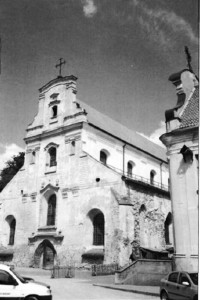
In the square between the church and the small Baroque Chapel of Sužinai, built at the beginning of the 18th century (next to Traku St.), there was a small cemetery, where at the beginning of the 20th century a monument was erected to Jozefas Montvila, a Vilnius benefactor.
The church was closed down by the Czarist authorities in 1864 during the great uprising of 1863-1865. In the inter-war years of the 20th century, it was returned to the Franciscans who renovated the church and the monastery in 1939.
During the half century of Soviet occupation, the church was closed down again and converted into a storehouse of the State Archives. The interior was badly ravaged, and the large Gothic belfry on Pranciš konu St. was demolished. Recently the church was returned to the Franciscan Brothers.
Aside from the Church of the Bernardines, which is located on the opposite side of the Old Town, this is perhaps one of the most devastated of all the churches in Vilnius. N ot much of its earlier Baroque splendor remains. It is amazing how much damage a foreign occupation and a despotic regime such as the Soviet communists can inflict on beautiful historic monuments and masterpieces of art and architecture. But restoration is in progress, and about half of the church’s exterior has been brought back to its original condition. The renovation of the interior does not show much progress yet, probably for lack of funds. Even so, churches like this one and the one of the Bernardines seem to attract many foreign tourists and weddings. Tourists accustomed to seeing churches in good condition are amazed to see what fifty years of foreign occupation can do to such a beautiful building. And young couples looking for an exotic locale, often choose these churches for their wedding ceremony. Standing inside gives you the impression of being in a movie set or in another faraway historic period.
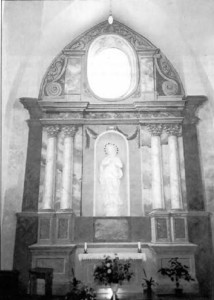
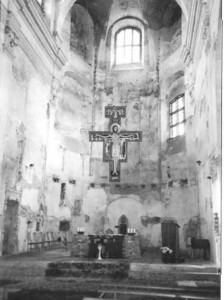
 DRAUGAS NEWS Lithuanian World Wide News in English
DRAUGAS NEWS Lithuanian World Wide News in English
